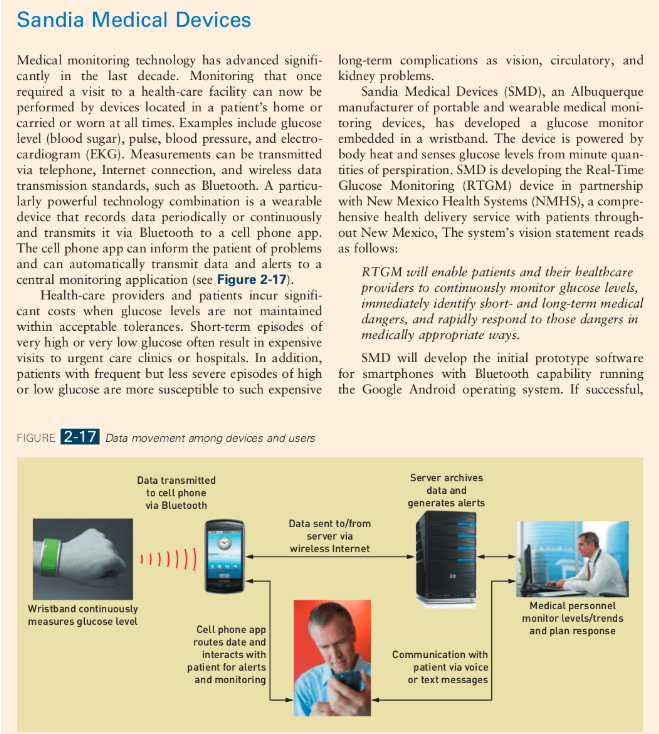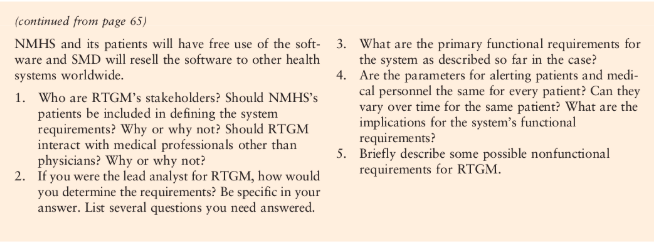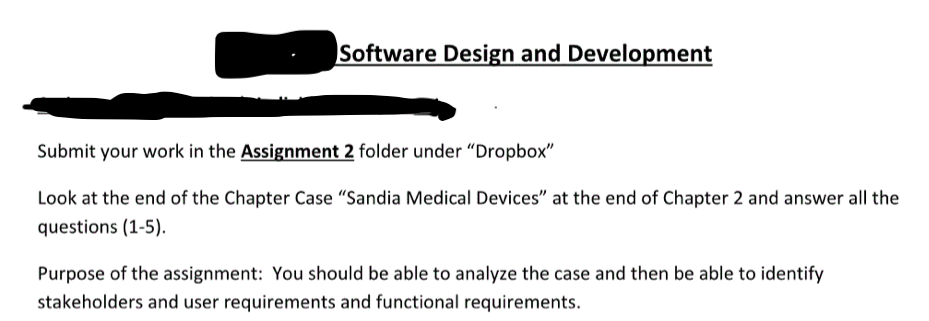Sandia Medical Systems Real Time Glucose Monitoring Mobile App Design
Software design and development Questions.



Sandia Medical Devices Medical monitoring technology has advanced signifi- long-term complications as vision, circulatory, and cantly in the last decade. Monitoring that once kidney problems. required a visit to a health-care facility can now be Sandia Medical Devices (SMD), an Albuquerque performed by devices located in a patient's home or manufacturer of portable and wearable medical moni- carried or worn at all times. Examples include glucose toring devices, has developed a glucose monitor level (blood sugar), pulse, blood pressure, and electro- embedded in a wristband. The device is powered by cardiogram (EKG). Measurements can be transmitted body heat and senses glucose levels from minute quan- via telephone, Internet connection, and wireless data tities of perspiration. SMD is developing the Real-Time transmission standards, such as Bluetooth. A particu- Glucose Monitoring (RTGM) device in partnership larly powerful technology combination is a wearable with New Mexico Health Systems (NMHS), a compre- device that records data periodically or continuously hensive health delivery service with patients through and transmits it via Bluetooth to a cell phone app. out New Mexico, The system's vision statement reads The cell phone app can inform the patient of problems as follows: and can automatically transmit data and alerts to a RTGM will enable patients and their healthcare central monitoring application (see Figure 2-17). providers to continuously monitor glucose levels, Health-care providers and patients incur signifi- immediately identify short- and long-term medical cant costs when glucose levels are not maintained within acceptable tolerances. Short-term episodes of dangers, and rapidly respond to those dangers in very high or very low glucose often result in expensive medically appropriate ways. visits to urgent care clinics or hospitals. In addition, SMD will develop the initial prototype software patients with frequent but less severe episodes of high for smartphones with Bluetooth capability running or low glucose are more susceptible to such expensive the Google Android operating system. If successful, FIGURE 2-17 Data movement among devices and users Data transmitted to cell phone via Bluetooth Server archives data and generates alerts Data sent to/from server via wireless Internet Wristband continuously measures glucose level Medical personnel monitor levels/trends and plan response Cell phone app routes date and interacts with patient for alerts and monitoring Communication with patient via voice or text messages (continued from page 65) NMHS and its patients will have free use of the soft- ware and SMD will resell the software to other health systems worldwide. 1. Who are RTGM's stakeholders? Should NMHS's patients be included in defining the system requirements? Why or why not? Should RTGM interact with medical professionals other than physicians? Why or why not? 2. If you were the lead analyst for RTGM, how would you determine the requirements? Be specific in your answer. List several questions you need answered. 3. What are the primary functional requirements for the system as described so far in the case? 4. Are the parameters for alerting patients and medi- cal personnel the same for every patient? Can they vary over time for the same patient? What are the implications for the system's functional requirements? 5. Briefly describe some possible nonfunctional requirements for RTGM. Software Design and Development Submit your work in the Assignment 2 folder under "Dropbox" Look at the end of the Chapter Case "Sandia Medical Devices" at the end of Chapter 2 and answer all the questions (1-5). Purpose of the assignment: You should be able to analyze the case and then be able to identify stakeholders and user requirements and functional requirements. Show transcribed image text Sandia Medical Devices Medical monitoring technology has advanced signifi- long-term complications as vision, circulatory, and cantly in the last decade. Monitoring that once kidney problems. required a visit to a health-care facility can now be Sandia Medical Devices (SMD), an Albuquerque performed by devices located in a patient's home or manufacturer of portable and wearable medical moni- carried or worn at all times. Examples include glucose toring devices, has developed a glucose monitor level (blood sugar), pulse, blood pressure, and electro- embedded in a wristband. The device is powered by cardiogram (EKG). Measurements can be transmitted body heat and senses glucose levels from minute quan- via telephone, Internet connection, and wireless data tities of perspiration. SMD is developing the Real-Time transmission standards, such as Bluetooth. A particu- Glucose Monitoring (RTGM) device in partnership larly powerful technology combination is a wearable with New Mexico Health Systems (NMHS), a compre- device that records data periodically or continuously hensive health delivery service with patients through and transmits it via Bluetooth to a cell phone app. out New Mexico, The system's vision statement reads The cell phone app can inform the patient of problems as follows: and can automatically transmit data and alerts to a RTGM will enable patients and their healthcare central monitoring application (see Figure 2-17). providers to continuously monitor glucose levels, Health-care providers and patients incur signifi- immediately identify short- and long-term medical cant costs when glucose levels are not maintained within acceptable tolerances. Short-term episodes of dangers, and rapidly respond to those dangers in very high or very low glucose often result in expensive medically appropriate ways. visits to urgent care clinics or hospitals. In addition, SMD will develop the initial prototype software patients with frequent but less severe episodes of high for smartphones with Bluetooth capability running or low glucose are more susceptible to such expensive the Google Android operating system. If successful, FIGURE 2-17 Data movement among devices and users Data transmitted to cell phone via Bluetooth Server archives data and generates alerts Data sent to/from server via wireless Internet Wristband continuously measures glucose level Medical personnel monitor levels/trends and plan response Cell phone app routes date and interacts with patient for alerts and monitoring Communication with patient via voice or text messages
(continued from page 65) NMHS and its patients will have free use of the soft- ware and SMD will resell the software to other health systems worldwide. 1. Who are RTGM's stakeholders? Should NMHS's patients be included in defining the system requirements? Why or why not? Should RTGM interact with medical professionals other than physicians? Why or why not? 2. If you were the lead analyst for RTGM, how would you determine the requirements? Be specific in your answer. List several questions you need answered. 3. What are the primary functional requirements for the system as described so far in the case? 4. Are the parameters for alerting patients and medi- cal personnel the same for every patient? Can they vary over time for the same patient? What are the implications for the system's functional requirements? 5. Briefly describe some possible nonfunctional requirements for RTGM.
Software Design and Development Submit your work in the Assignment 2 folder under "Dropbox" Look at the end of the Chapter Case "Sandia Medical Devices" at the end of Chapter 2 and answer all the questions (1-5). Purpose of the assignment: You should be able to analyze the case and then be able to identify stakeholders and user requirements and functional requirements.
Sandia Medical Systems Real Time Glucose Monitoring Mobile App Design
Source: https://www.boutsolutions.com/ExpertAnswers/software-design-and-development-questions-sandia-medical-devices-medical-monitoring-technology-has-a
Posted by: pittmancalown.blogspot.com

0 Response to "Sandia Medical Systems Real Time Glucose Monitoring Mobile App Design"
Post a Comment